
Decentralized cryptocurrency exchanges have always been one of the more interesting concepts to come out of the crypto space. To this day, they are still often shrouded in mystery, especially to newcomers in the field. In this Vertex Protocol review, we’ll talk about a project that aims to eliminate some of that mystery.
Vertex is just that - a DEX (decentralized exchange). However, it’s actually quite special in its design - it’s a newly-created DEX that aims to bridge the gap between centralized exchange usability and decentralized platform self-custody and transparency. Naturally, as you might expect, that’s not an easy goal to accomplish!
As of writing this, Vertex currently has a testnet available to be tried out by the initial crypto enthusiasts that would take interest in the project. The project’s Litepaper reveals that there’s a solid roadmap in place, however, and that the company already has a lot of things figured out.
Let’s not get too far ahead, however, and start from the beginning.
Stop overpaying - start transferring money with Ogvio. Sign up, invite friends & grab Rewards now! 🎁
Pros
- A unique DEX project
- Crypto self-custody
- An emphasis on user experience
- Vertically-integrated exchange model
- VRTX - native governance token
- Very fast order matching
Cons
- Still not fully launched
- Might be a bit complicated for beginners
Table of Contents
- 1. What is Vertex Protocol?
- 2. Vertex Protocol Review: PROS
- 2.1. Self-Custodial Exchange - You Control Your Assets
- 2.2. A DEX With CEX-Level Features & Functionalities
- 2.3. Super-Fast Order Matching
- 2.4. VRTX Coin - The Governance Token of Vertex
- 2.5. Seamless Fiat-to-Crypto Conversions
- 3. Vertex Protocol Review: CONS
- 3.1. The Platform Isn’t Launched Yet
- 3.2. Might Not be the Best Option for Beginner Traders
- 4. Conclusions
What is Vertex Protocol?
Now, then - before we jump into some of the more technical stuff, let’s have a proper breakdown of what is Vertex Protocol, and how it works.
First and foremost, Vertex Protocol is a DEX - a decentralized exchange; we’ve covered that much already. What this means, however, is that the platform is completely non-custodial - in other words, when you perform trades on Vertex, you and you alone are going to have access to your funds. The exchange isn’t going to store them, nor keep them on their system.
The story of how Vertex became a DEX is actually a pretty interesting one, as well. Initially, the project wasn’t supposed to be a decentralized crypto exchange - instead, the company behind it started building a decentralized Forex platform. This was back in early 2021.
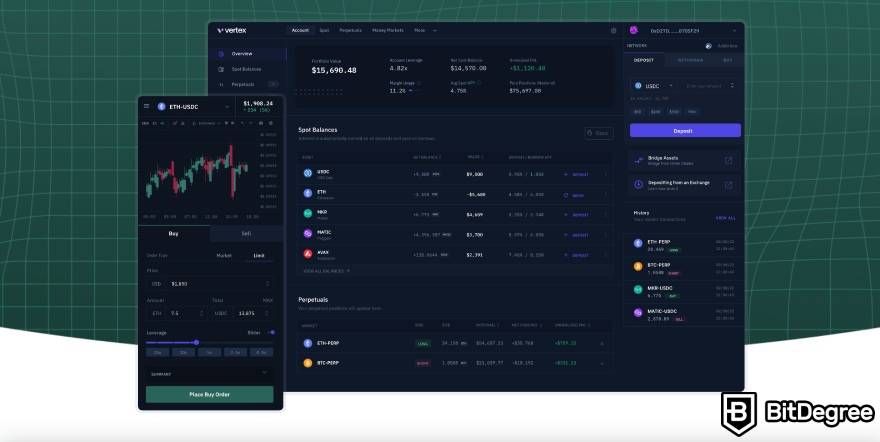
How is the year important? Well, reading through other user Vertex Protocol reviews, you will quickly learn that Vertex was also originally based on the Terra blockchain.
If you’ve spent even a slight amount of time in the crypto space, you probably know what happened with Terra, and its underlying stablecoin, Luna. If not, however, allow me to fill you in - after Luna depegged from its $1 price, and a series of allegations against Terra’s founder surfaced, claiming that the asset was never backed, in the first place, Terra collapsed, in May of 2022.
Naturally, this was some really bad news to projects that were built (or were being built) on the Terra network, Vertex included. However, granted that you’re reading this Vertex Protocol review, you can probably tell that the team behind the project found a way out - namely, a complete relocation to the Arbitrum network, and a total rebranding of its service model.
This is where the current goals of the platform come in - it becoming a decentralized exchange that would house the main features and functionalities of any high-end centralized platform, such as Binance, Kraken, or KuCoin.

These goals are, obviously, quite unique - a single glance at the crypto market today will reveal that there aren’t really many services that would be following a similar path. At the same time, however, Vertex addresses one of the biggest challenges that the decentralized exchange industry has faced, since the dawn of time - user experience, and CEX-favoring user onboarding.
Specifically, many DEX platforms out there, while being adored and used by thousands of crypto fans, come with some very awkward and beginner-unfriendly functionality. To add to that, these exchanges are often guidance-free - either you know what you’re doing, straight from the get-go, or you’ll have to figure it out yourself.
Vertex addresses all of that, and much more. I’m getting ahead of myself, however - let’s take it from the top.
Vertex Protocol Review: PROS
The earlier-mentioned goal that Vertex has is certainly ambitious, but the platform does already have a lot of positive features that can certainly help it navigate towards it. At the very top, you have the promise of foundational DEX-specific features, such as self-custody.
Self-Custodial Exchange - You Control Your Assets
While decentralized exchanges tend to be scrutinized for a lot of different things, most crypto enthusiasts would agree that the core strength that the platforms possess is the fact that they are non-custodial. User Vertex Protocol reviews will tell you that the protocol in question is no different - it offers self-custody to its clients.
What this essentially means is that you are the only person who’s going to have access to their funds, at any point in time. I’ve mentioned this earlier in the Vertex Protocol review, but it’s absolutely crucial that you understand this to the fullest extent.
Self-custody means that you’ll be keeping your crypto in a separate wallet that has nothing to do with the Vertex Protocol exchange. When you perform transactions, lend or borrow assets, or do any other actions on the DEX, the platform will only work as a facilitator of those actions - it will not hold any of your assets, at any time.
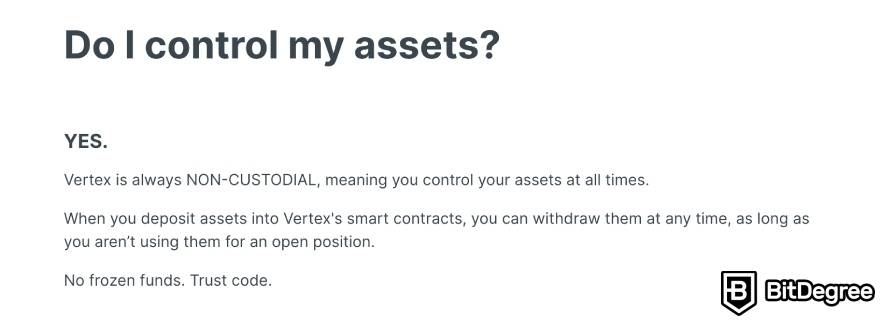
Naturally, as you can probably imagine, this is a huge deal when it comes to security and anonymity. It would seem like there’s a new horror story surrounding a break-in into some centralized exchange, every single day. DEXs such as Vertex are one of the solutions to such problems!
Do keep in mind, though, that every coin has two sides - self-custody is no exception. Since you’ll be the only one responsible for your funds, it will also be solely your responsibility to make sure that they are safe, as well. This, in turn, means that you’ll need to have a lot of general knowledge when it comes to crypto - how to spot fishy situations, how to avoid malicious dApps, and so on.
Either way you look at it, though, the fact of the matter remains the same - the Vertex Protocol DEX adheres to the core principle of decentralized crypto trading, that being self-custody.
A DEX With CEX-Level Features & Functionalities
Reading through user Vertex Protocol reviews, you will soon find out that one of the core features of the exchange is the fact that it promises CEX-level usability and functionality, but built on a decentralized model.
If done correctly, this can actually be a revolutionary take on the decentralized exchange market - it’s that big of a deal!
DEXs have always struggled to attract newbie crypto enthusiasts, simply due to the fact that they are often very confusing and difficult to start using. In addition to multiple understandable prerequisites (such as already having a dedicated wallet, and topping it up with a select asset), there are also many other things to keep track of, as well.

Are your cryptos on the right network? Do you need to use a bridge? What sort of slippage do you need to set in your trades? Do you even have the correct project contract, or is it a fake that trying to steal all of your crypto coins and tokens?
If you’re new to the world of crypto, all of these things can really put you off from using a decentralized exchange. This is more so true when you consider the fact that none of the questions mentioned above apply to CEXs - when you register, you’ll be able to generate an in-exchange wallet, and start trading in just a couple of steps. The exchange will take care of everything else.
Industry newcomers aside, DEXs can also turn experienced traders away, as well, due to their common lack of advanced features. If you’re looking to borrow or lend cryptocurrencies, or perform margin or leverage trades, oftentimes, this will mean going out of your way and finding dedicated dApps that would allow you to do so.
Yet another argument for why enthusiasts would pick a CEX over a DEX. The Vertex Protocol exchange aims to address and solve this.
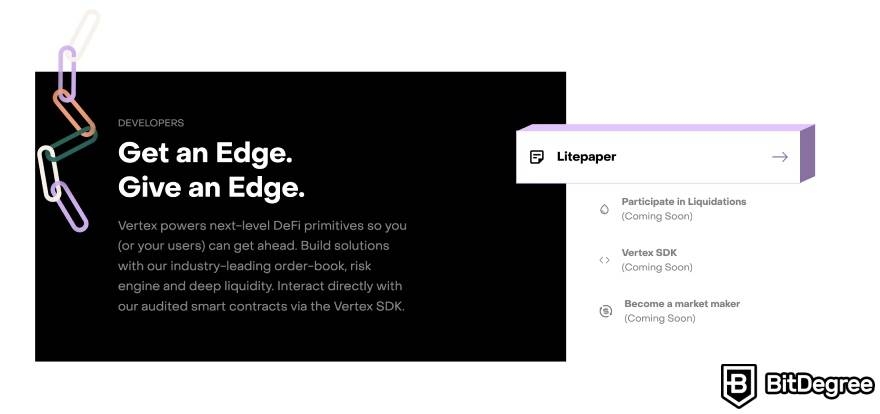
During their upcoming initial MVP (Minimal Viable Product) launch, Vertex aims to start off with three main features - a spot market, perpetual contracts (long and short position trades), and a market for asset borrowing and lending. As time goes on, more and more features will be added to the exchange.
Even so, the three initial features do already cover a lot of the aspects that most of the more casual traders would be interested in using. The best part is that all of these features will come bundled in a single user-friendly dashboard that can already be tried out and tested on the Vertex official testnet (something that I talk about in my dedicated Vertex tutorial).
Summing it up, it’s worth pointing out that Vertex utilizes a “VERTically-integrated EXchange” model in the business approach (this is where the name of the project originated from, as well). This type of a business model is usually associated with centralized exchanges, and if anything, it helps the platform in question retain its feature variety and optimal user experience.
Super-Fast Order Matching
Order-matching speed is a concept that essentially refers to how quickly the underlying exchange engine manages to match your order with that of another person, and then execute it. At first glance, it might seem like a bit of a trivial aspect - however, if you look into it a bit further, you will soon notice that it’s actually extremely important.
The importance mostly lies in the trading experience that you'll have.
Order-matching speed is going to determine how fast the trades that you've placed are going to be executed, after you actually place them. If you want to feel the importance of this specific feature, you can simply go to a decentralized exchange, and trade some popular crypto pair on it.
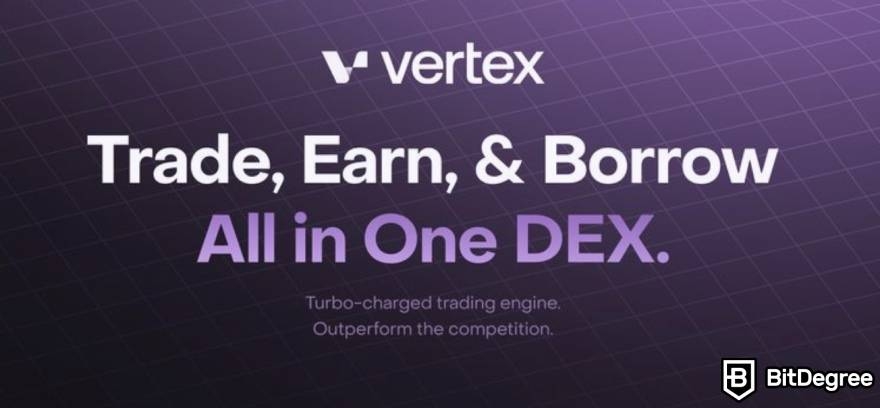
Chances are that this trade will take a much longer time to be executed than it would on a centralized exchange platform - it's one of the more common reasons why people often choose to go the CEX route, too!
Due to their infrastructure, CEXs tend to offer some of the best order-matching speeds. DEXs, on the other hand, often lag behind - this is especially true when it comes to Ethereum-based platforms, due to the congestion that the Ethereum network sometimes suffers.
User Vertex Protocol reviews will tell you that the platform in question is adamant about addressing this specific issue. One of the ways of how it does so is by employing Arbitrum, the network on which the whole project is built.
Arbitrum is a Layer-2 scaling solution for Ethereum. It allows projects built within its ecosystem to worry less about the aforementioned issue of congestion, as well as scale much better thanks to improved efficiency models of the network itself.
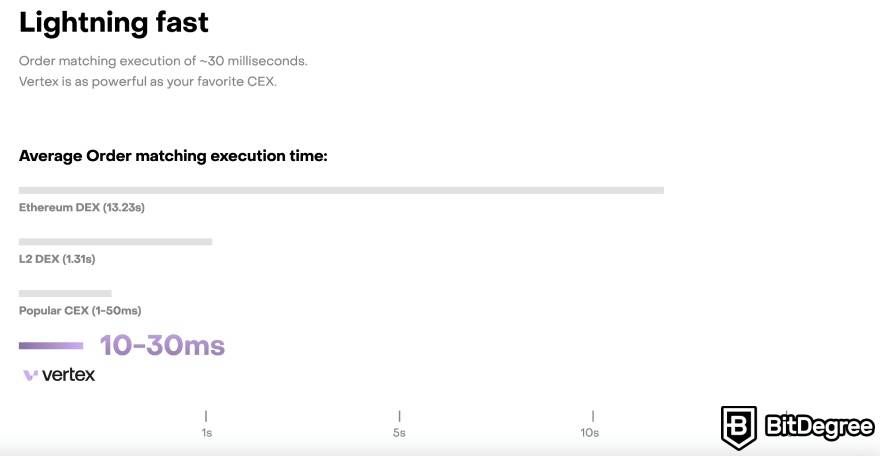
All of that combined, the Vertex Protocol DEX promises order-matching speeds of around 30 milliseconds. Not only is it very notable in the realm of DEXs, but it definitely competes with many centralized exchanges, as well!
This is great news for any type of trader, sure, but it’s especially significant to people who arbitrage crypto, as their preferred trading strategy. Not going too deep into it, arbitrage trading is a popular trading method where you would buy crypto on one exchange, and then sell it on another, where the price is higher.
As you can imagine, arbitrage traders face A LOT of competition. Thus, it’s absolutely crucial that they perform their trades on exchanges that offer super-fast order-matching. The Vertex Protocol exchange is one such platform!
VRTX Coin - The Governance Token of Vertex
The absolute majority of crypto projects nowadays come equipped with a native asset of their own - Vertex is no exception. The platform will utilize something called the VRTX coin.
Fundamentally, the purpose of VRTX will be that of governance facilitation. This is because, after launch, Vertex aims to employ a decentralized governance model. In a situation like this, supporters and users of the platform are going to have the final say on the changes made on it, as well as any and all updates that might be applied to its operations.
This should also work to answer questions such as “is Vertex Protocol safe?” - DAO-like governance is often quite sought-after, by crypto security enthusiasts.

How is all of this related to the VRTX coin? Well, a platform-exclusive spinoff of this token - voVRTX - will be used in the voting process of said governance. In other words, token holders will have a say in the aforementioned changes and updates that the exchange might receive.
Going back to the VRTX coin itself, this asset will have two major use cases - it will allow the holder to earn a portion of the protocol's revenue, as well as provide discounts on trading fees. It’s a pretty common and effective mixture of use cases that many similar projects utilize, as well.
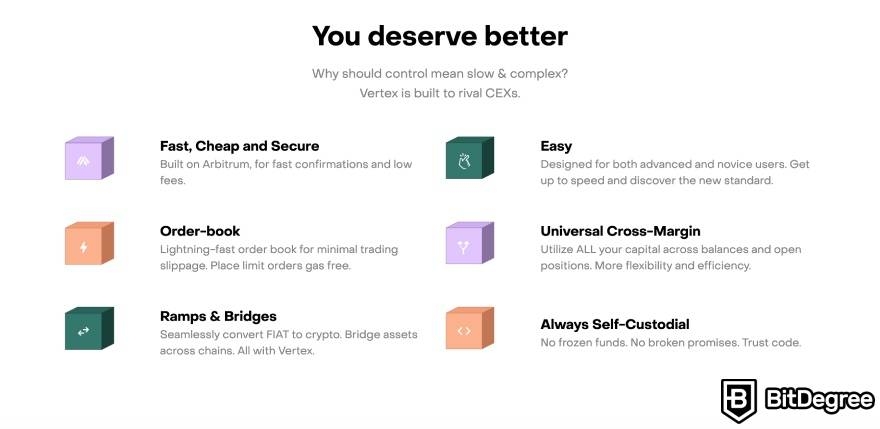
Lastly, there’s also the xVRTX token. This is the stakeable version of the original VRTX coin. It can be used to either back up the insurance fund present on the DEX, or locked for a period of two weeks, in a staking contract (where it would earn a passive yield for the holder).
All things considered, it’s clear that the VRTX coin has some clear use cases, both in regards to generalized potential financial gain, as well as making sure that the answer to the question “is Vertex Protocol safe?” remains a positive one.
Seamless Fiat-to-Crypto Conversions
This is, admittedly, one of the more interesting features mentioned in user Vertex Protocol reviews.
One of the bigger issues that decentralized exchanges face is the fact that they usually lack a fiat on-ramp. In other words, there’s no way for users of these platforms to purchase cryptocurrencies for fiat money, via the underlying exchange. DEXs are essentially only crypto-crypto trading platforms.
This is also one of the biggest arguments that sway a lot of people away from decentralized exchanges, and towards centralized crypto trading platforms, too. That’s because CEXs do have this type of functionality - the vast majority of established centralized exchanges allow their users to purchase assets via credit / debit cards, bank transfers, etc.

The Vertex Protocol DEX does, for a fact, offer its users the ability to purchase crypto with fiat money, receive those assets straight into their dedicated crypto wallet, and then start trading. This is done with the help of bridges.
Bridging is a rather complex topic, when it comes to the crypto ecosystem, so I won’t get too deep into it here. Suffice to say that, in regards to Vertex, the DEX would allow you to connect your personal wallet with a dedicated fiat on-ramp, which would then allow you to purchase cryptocurrencies for USD, EUR, and other major fiat currencies.
This is quite unheard of, in the realm of decentralized exchanges! However, it does fall in line with the philosophy of Vertex - that of offering CEX-level functionality on a DEX platform.

Did you know?
All Crypto Exchanges may look similar to you but they're NOT all the same!
Vertex Protocol Review: CONS
Now that we have all of the major features and benefits of the exchange in question covered, let’s turn this Vertex Protocol review towards the complaints that users of the platform might have. While there aren’t many negative sentiments associated with Vertex, you’ll find that some users do have a couple of concerns that should be addressed, either way.
The Platform Isn’t Launched Yet
This is a pretty obvious point, and one that doesn’t actually fall under the “con” umbrella, necessarily. However, it’s still something that’s worth mentioning, nonetheless.
As of me writing this Vertex Protocol review, the underlying exchange is yet to be launched. Currently, there’s a testnet version available for users to check out, as well as give feedback on. The team behind the platform is working on releasing the live version of the DEX on the mainnet as soon as possible.
As I’ve said earlier, this isn’t necessarily a con per se, since there are a lot of products out there that are still being developed, even when there’s already a growing potential user base. In fact, it can even be viewed as a good thing, as well - many crypto enthusiasts strive to be early adopters of this revolutionary piece of technology, and unique projects such as the Vertex Protocol DEX are one way of doing it.
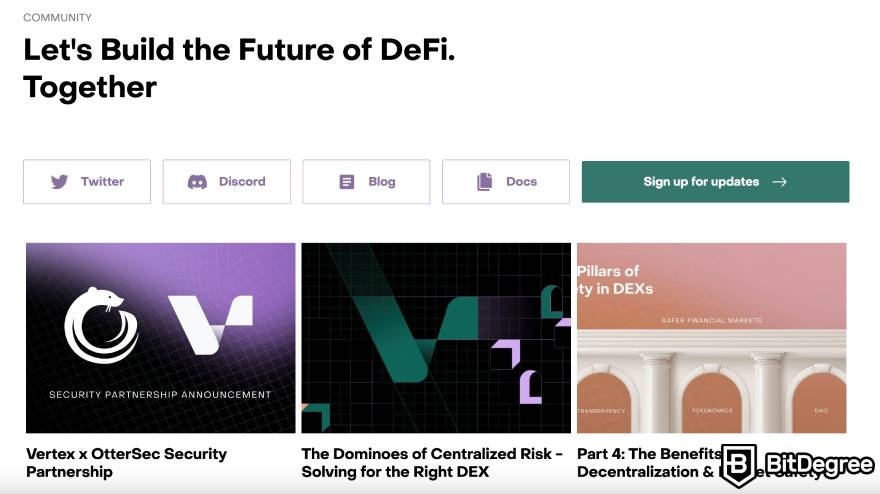
On the flip side, though, you might come across user Vertex Protocol reviews expressing a certain weariness towards this fact. Specifically, some users might have time pressure associated with their trading ventures, and thus, they would try and go and search for platforms that are already released, and that they could start using immediately.
Something that also adds to this is the fact that there isn’t any specific official release date for Vertex, as well - at least not anywhere that would be obvious to the visitor of the project’s official website. Once again, this creates a feeling of uncertainty, and even though the project looks extremely promising, it might still turn certain people away.
Might Not be the Best Option for Beginner Traders
One of the key points that Vertex promotes itself on is the fact that it’s quite simple to use, especially when compared to other decentralized exchanges that are currently present within the space. From everything that we’ve talked about in this Vertex Protocol review, it does appear to be the case!
However, simplicity is also something that is rather subjective, too. Vertex might have a really great user experience proposition when it comes to people who are already familiar with crypto, but things could be different in regards to complete crypto newbies.

If you yourself have never used a crypto service before, and haven’t even gotten around to purchasing your very first cryptocurrency, chances are that Vertex is going to appear as a rather complex platform. This is especially true since you do already need to have a funded crypto wallet in order to start using it.
To add to that, the Vertex Protocol exchange also focuses on a lot of its advanced features - things such as cross-margin functionality, leverage trading, lending & borrowing, and similar. Many of these features, while much appreciated by advanced-level traders, are going to be pretty confusing to anyone who’s just starting out their crypto journey.
Lastly, the current dashboard of the Vertex exchange. While the interface is still in its testnet phase, and things might change before the final launch of the product, the dashboard retains a bit of a complex look, information presentation-wise. While it’s nothing compared to the traditional interfaces that you’d find on decentralized exchanges, it can still come off as confusing, especially for industry newcomers.
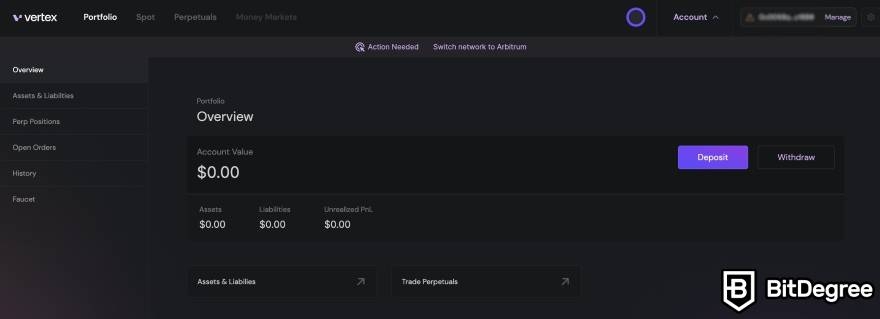
If you’d like to learn more about the current ongoing testnet, and how to use the Vertex Protocol, in a very general sense, I will be writing a dedicated tutorial on the topic - you’ll be able to find it here.
As a sort of leverage against the point made above, the tutorial will help you start your journey with Vertex, at least from a testnet perspective, and will teach you how to use the aforementioned dashboard of the exchange, on a fundamental level.

- Secure and reliable
- Accepts fiat currencies
- Lots of trading options
- Reputable exchange
- Accepts fiat currencies
- Offers various trading options

- Huge trading variety
- Regulation-compliant around the globe
- Fair trading fees
- Beginner-friendly
- A wide array of features
- Vast number of different crypto coins & tokens

- Beginner-friendly
- Secure
- Decent trading and withdrawal fees
- Crypto.com Visa Card
- Automated tools & bots
- Ecosystem synergy with CRO
Conclusions
So, then - that wraps up our Vertex Protocol review! We’ve discussed both the most notable features and benefits of the project, as well as some shortcomings that are worth keeping in mind, before you check it out yourself.
Speaking of which, what’s the verdict here - is the Vertex Protocol exchange worth checking out, or should you stick with the traditional decentralized exchanges?
Well, I would say - Vertex is certainly one of the most unique exchange projects to come out of the crypto industry in the past couple of years, and is thus definitely worth at least checking out!
While decentralized exchanges might not be everyone’s cup of tea, even with advanced functionality and features, Vertex aims to bridge the gap between the transparency and self-custody of DEXs, and the user experience of centralized exchange platforms. It’s a very unique approach to decentralized cryptocurrency trading!
Evidently, if you’re just starting out with crypto, and are yet to create your very first wallet or purchase your first assets, Vertex might prove to be a bit complicated (even though you can check out my dedicated tutorial on how to navigate the project). If you’re already an intermediate-level trader, however, Vertex could have a lot to offer!
The benefits of the platform include things such as an elaborate dashboard, a native governance token, multiple security features (answering the question - is Vertex Protocol safe?), a vertically-integrated exchange model, and many more - all of which make the project a unique proposition to crypto enthusiasts searching for new and interesting opportunities!
With all of that being said, thanks for reading my Vertex Protocol review, and until next time!
The content published on this website is not aimed to give any kind of financial, investment, trading, or any other form of advice. BitDegree.org does not endorse or suggest you to buy, sell or hold any kind of cryptocurrency. Before making financial investment decisions, do consult your financial advisor.


